113/2 Shelves


Basket
Name/Title
Basket
Lexicon
Description
Vasiform ash splint basket, with radial start, intact bail, and rim affixed with clinched nails. Marked "Daisey."
Ethnography
Made/Created
Date made
circa 1920
Materials
Material
Ash Splint
Entry/Object ID
L2024.3.60
Context
Occasionally the Sweetsers made exquisite small, vase-shaped baskets. This one found in Essex Junction, Vermont, was made with extraordinary precision in the splints, the weaving, and the distinctive clinched nail rim, and can be considered a piece of Art.


Basket
Name/Title
Basket
Lexicon
Description
Round basket with lid. Woven of black ash splints. Both basket and lid are decorated with three horizontal bands of twisted splints. Lid has small, integral bail.
Acquisition
Source (if not Accessioned)
Abenaki Cultural Conservancy
Ethnography
Made/Created
Artist Information
Larocque, Jesse James (b. 1961)
Artist
Date made
2000
Materials
Material
Ash Splint
Entry/Object ID
L2024.3.100a-b


Basket
Name/Title
Basket
Lexicon
Description
Round basket and lid woven from split and plaited sweetgrass. The Lid is woven in alternating sections of black-dyed weavers and plaited sweetgrass with six splint loops at the center. The basket is made of black-dyed splint weavers at the bottom and plaited sweetgrass at the top.
Acquisition
Accession
2004.18
Relationships
Related Person or Organization
Dole, Sylvia Johnson (1940-2008)
Person or Organization
Related Places
Place
Plainfield
Town
Washington County
County
Vermont
State/Province
United States of America
Country
North America
Dimensions
Dimension Description
Overall
Materials
Material
Sweetgrass, Wood
Entry/Object ID
2004.18.1a-b
Context
Owned by the Martin or Johnson families of Plainfield, Vermont


Basket
Name/Title
Basket
Lexicon
Description
Round basket, daub dyed blue, radial start and thin weavers
Acquisition
Source (if not Accessioned)
Abenaki Cultural Conservancy
Ethnography
Made/Created
Date made
circa 1870
Dimensions
Materials
Material
Ash Splint
Entry/Object ID
L2024.3.99
Context
This basket style is much more common in Maine, while the more westerly examples tend to have square bottoms formed by the rectilinear pattern of the weavers. It may be an import from further east but is good for comparative purposes.


Basket
Name/Title
Basket
Lexicon
Description
Square basket woven of ash splints with varying width weavers. Select splints are dyed on the exterior surface blue or red.
Acquisition
Source (if not Accessioned)
Abenaki Cultural Conservancy
Ethnography
Made/Created
Date made
circa 1860
Dimensions
Materials
Material
Ash Splint
Entry/Object ID
L2024.3.74
Context
This large utility basket from the Northeast Kingdom has varying width weavers; with some of them “daub-dyed” with Prussian blue and red ochre. You can see that the dye only appears on the outside faces of the splints. Although the color is similar to the much more common round “Penobscot” radial-start baskets, their construction technique, based on a checkerboard start is regionally distinctive.


Basket
Name/Title
Basket
Lexicon
Description
Round, open-work, ash splint basket with attached ash handles. Radial start with bound rim. Mostly narrow natural splints with two wide bands near rim. Bands dyed yellow and blue.
Acquisition
Source (if not Accessioned)
Abenaki Cultural Conservancy
Ethnography
Made/Created
Date made
circa 1880
Dimensions
Materials
Material
Ash Splint
Entry/Object ID
L2024.3.103
Context
This early open work basket from Morrisville, VT with the two loop handles was produced in prodigious quantities if surviving examples are any indication. This one is illustrated because it not only has the usual Prussian blue daub- dye but applied red [don't see red in photo] and a rare yellow pigment as well.
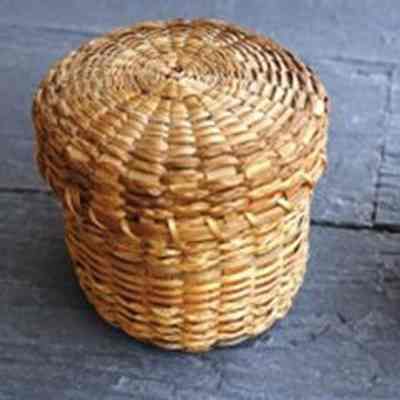

Basket
Name/Title
Basket
Lexicon
Description
Round woven basket and lid constructed of ash splints and sweetgrass.
Acquisition
Source (if not Accessioned)
Abenaki Cultural Conservancy
Ethnography
Notes
The Vermont Gypsies were a well-known part of life along old Route 15 before WWII (there is 1990’s testimony from Abenaki gypsy descendants that the lifestyle subsided in the early 1930’s because of the Eugenics Survey). They would arrive in town in a couple horse drawn wagons and set up camp on a friendly farmer’s field. They traded their labor and craft arts for feed for their horses as well as food and cash. Horse feed seemed to be their most important economic need.
Information from a 1990s Johnson State College oral history project includes:
Although their main product was the “Indian Basket,” people along Rt. 15 did not think of them as Indian, but a few described them as mixed blood. Two people reported that the women wore more scarves than anyone they had seen and one thought that was the main characteristic of gypsies. There were no reports of beads or jewelry except small crucifixes, one report of a man wearing a silver religious medal. The horses and the wagons were in good shape and there were sometimes well behaved “camp dogs” present. One elderly informant from Johnson, Vermont told of “sneaking off to hang out with the Gypsies” in the 1920’s and gave a bit of detail, including 1. they spoke another language but English in camp; 2. Their food smelled different than “Vermont food;” 3. They were very friendly and respectful, when not doing chores, everyone around camp was working on crafts, even the older children. There were a few other impressions, not negative, but nevertheless would be considered inappropriate today such as body odor and assumed sexual conduct. The men helped with farm work and did minor repairs such as blade sharpening and repairing pots and pans with little tin and aluminum patches. One man from Jeffersonville said that his family only rarely sharpened its farm tools and kitchen knives because the gypsies could put an amazing edge on a chisel or knife without “cheap and wearing the blade.” A person in Jericho reported seeing snowshoes for sale, and a miniature pair of snowshoes was sold in Jericho, the only example of a tourist miniature being sold. We have story of a “wolf fur” coat sold by the gypsies in Jericho and one of the set of small “porch chairs” chairs the men made by hand in back of the Smuggler’s Notch Inn in Jeffersonville. There were no reports of them selling herbal medicines, but they did collect herbs in the woods and on the Lamoille and Gihon River riverbank. They were said to have wintered in the pine woods in Burlington where the airport is now and traveled as far east as Danville (this was confirmed by Don Stevens, whose ancestors did the route 15 circuit).
Professor Jim Petersen of the University of Vermont, in conversation regarding his mother’s sweetgrass basket, said that she bought it from the Gypsies when they passed through Salisbury, VT (Rt. 7) before WWII, and she told Jim that she always knew that the Gypsies were Indian.
Made/Created
Date made
circa 1925
Dimensions
Materials
Material
Sweetgrass, Ash Splint
Entry/Object ID
L2024.3.91a-b
Context
This little ash splint and sweetgrass “fancy basket,” along with L2024.3.92a-b, are very important because they were sold to Mrs. Waterman of Johnson, Vermont in the 1920’s or early 30’s by "Gypsies" who camped on a farm to the west of town. Almost all ash and sweetgrass fancy baskets lack such documentation and could have been made anywhere and brought back to Vermont as souvenirs. There are interesting interview notes on what the people of Johnson thought of the "Gypsies" at the time.


Basket
Name/Title
Basket
Lexicon
Description
Open-work, ash splint basket. Varying width splints alternating blue dyed and natural. Square base with round top. Slightly Vasiform.
Acquisition
Source (if not Accessioned)
Abenaki Cultural Conservancy
Ethnography
Made/Created
Date made
circa 1880
Dimensions
Materials
Material
Ash Splint
Entry/Object ID
L2024.3.105
Context
This basket is the archetype of the late 1800’s Vermont Abenaki basket. It is classed as an “open work basket,” and is the most commonly found basket with good Vermont Native provenance, although this one’s origin is a bit less secure. Although it is now missing the two loop handles, the rest of it is in great shape. One thing that is interesting is that the dye is not just on the outside, like other work baskets such as L2024.3.103, but it also stains the inside of the splints, as can be seen in the illustration. One of the defining separations between 19th and 20th century baskets is the fact that 20th century splints were submerged in the dye which stains both sides. This may be a transitional basket using a dark, non-fugitive pigment like earlier baskets, while dipping rather than daubing on the dye -- like later basketry examples.
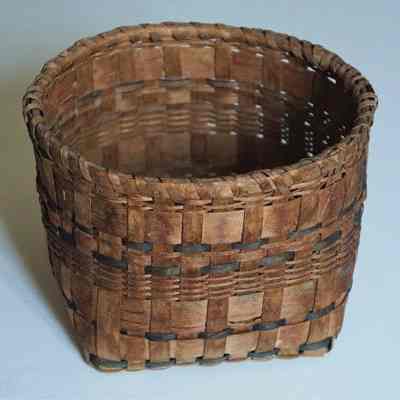

Basket
Name/Title
Basket
Lexicon
Description
Round basket with square base woven of ash splints. Select splints are dyed on the outer surface either blue or red.
Acquisition
Source (if not Accessioned)
Abenaki Cultural Conservancy
Ethnography
Made/Created
Date made
1840-1860
Dimensions
Materials
Material
Ash Splint
Entry/Object ID
L2024.3.75
Context
This small utility basket from central New Hampshire has varying width weavers with select splints “daub-dyed,” dyed on one surface only, with Prussian blue and red ochre. These small baskets are uncommon.
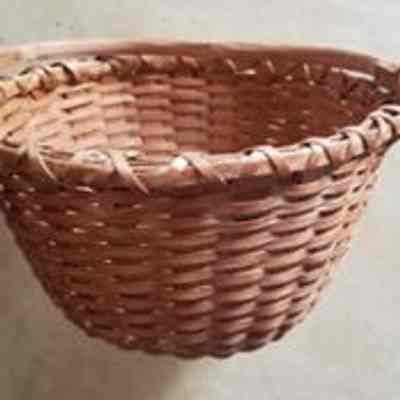

Basket
Name/Title
Basket
Lexicon
Description
Ash splint basket made in the Sweetser style. Round form with bound rim and bent-wood bail.
Acquisition
Source (if not Accessioned)
Abenaki Cultural Conservancy
Made/Created
Artist Information
Washburn, Newton Everett (1915-2011)
Artist
Date made
circa 1980
Materials
Material
Ash Splint
Entry/Object ID
L2024.3.61
Context
Newt Washburn tourist basket
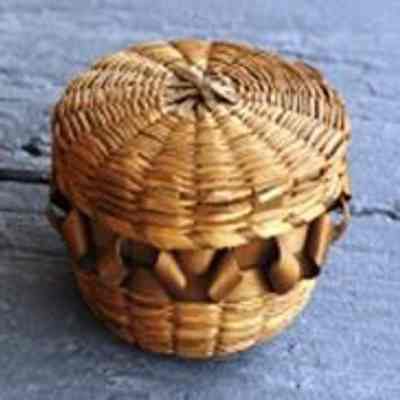

Basket
Name/Title
Basket
Lexicon
Description
Small, round, lidded trinket basket woven of sweetgrass and ash splints. Band of decorative, twisted splints around midline of basket.
Acquisition
Source (if not Accessioned)
Abenaki Cultural Conservancy
Ethnography
Notes
The Vermont Gypsies were a well-known part of life along old Route 15 before WWII (there is 1990’s testimony from Abenaki gypsy descendants that the lifestyle subsided in the early 1930’s because of the Eugenics Survey). They would arrive in town in a couple horse drawn wagons and set up camp on a friendly farmer’s field. They traded their labor and craft arts for feed for their horses as well as food and cash. Horse feed seemed to be their most important economic need.
Information from a 1990s Johnson State College oral history project includes:
Although their main product was the “Indian Basket,” people along Rt. 15 did not think of them as Indian, but a few described them as mixed blood. Two people reported that the women wore more scarves than anyone they had seen and one thought that was the main characteristic of gypsies. There were no reports of beads or jewelry except small crucifixes, one report of a man wearing a silver religious medal. The horses and the wagons were in good shape and there were sometimes well behaved “camp dogs.” present. One elderly informant from Johnson, Vermont told of “sneaking off to hang out with the Gypsies” in the 1920’s and gave a bit of detail, including 1. they spoke another language but English in camp; 2. Their food smelled different than “Vermont food;” 3. They were very friendly and respectful, when not doing chores, everyone around camp was working on crafts, even the older children. There were a few other impressions, not negative, but nevertheless would be considered inappropriate today such as body odor and assumed sexual conduct. The men helped with farm work and did minor repairs such as blade sharpening and repairing pots and pans with little tin and aluminum patches. One man from Jeffersonville said that his family only rarely sharpened its farm tools and kitchen knives because the gypsies could put an amazing edge on a chisel or knife without “cheap and wearing the blade.” A person in Jericho reported seeing snowshoes for sale, and a miniature pair of snowshoes was sold in Jericho, the only example of a tourist miniature being sold. We have story of a “wolf fur” coat sold by the gypsies in Jericho and one of the set of small “porch chairs” chairs the men made by hand in back of the Smuggler’s Notch Inn in Jeffersonville. There were no reports of them selling herbal medicines, but they did collect herbs in the woods and on the Lamoille and Gihon River riverbank. They were said to have wintered in the pine woods in Burlington where the airport is now and traveled as far east as Danville (this was confirmed by Don Stevens, whose ancestors did the route 15 circuit).
Professor Jim Petersen of the University of Vermont, in conversation regarding his mother’s sweetgrass basket, said that she bought it from the Gypsies when they passed through Salisbury, VT (Rt. 7) before WWII, and she told Jim that she always knew that the Gypsies were Indian.
Made/Created
Date made
circa 1925
Dimensions
Materials
Material
Sweetgrass, Ash Splint
Entry/Object ID
L2024.3.92a-b
Context
This little ash splint and sweetgrass “fancy basket,” along with L2024.3.91a-b, is very important because they were sold to Mrs. Waterman of Johnson, Vermont in the 1920’s or early 30’s by "Gypsies" who camped on a farm to the west of town. Almost all ash and sweetgrass fancy baskets lack such documentation and could have been made anywhere and brought back to Vermont as souvenirs. There are interesting interview notes on what the people of Johnson thought of the "Gypsies" at the time.


Basket
Name/Title
Basket
Lexicon
Description
Green splint basket with curlicues and sweetgrass edging. One row of curlicues on the lid and one on the side of the basket. The weavers are narrow, 1/16" wide, except for row with curlicue. The rim of the basket is banded on the outside by dark green splint and on the inside by natural color splint and wound with green (no breaks). The lid is banded on the outside with sweetgrass and the inside by green splint and wound with green splint (no breaks).
Acquisition
Accession
2011.9
Dimensions
Dimension Description
Overall
Materials
Material
Splint, Sweetgrass
Entry/Object ID
2011.9.1a-b
Context
Owned by Cora C. Calderari


Basket
Name/Title
Basket
Lexicon
Description
Incomplete strawberry basket with mold
Acquisition
Source (if not Accessioned)
Abenaki Cultural Conservancy
Made/Created
Date made
1930
Dimensions
Entry/Object ID
L2024.3.73a-b
Context
Wiseman comments: This was purchased from an antique dealer, who I trust, bought it from a yard sale in Barnstead, NH. No more is known of the provenance. The red basket preform is an obvious incomplete “strawberry” basket sill tightly clinging to its softwood mold. It was an important purchase in that there are scores of these in-progress baskets on their mold from better known Haudenosaunee and Wabanaki basket making areas, and this one was at least in the American Abenaki area for a long time.


Basket
Name/Title
Basket
Lexicon
Description
Open-work, ash splint basket. Square base and round rim.
Use
Herb collection and drying
Acquisition
Source (if not Accessioned)
Abenaki Cultural Conservancy
Ethnography
Made/Created
Date made
circa 1900-circa 1930
Dimensions
Materials
Material
Ash Splint
Entry/Object ID
L2024.3.106
Context
Wiseman comments: This is a questionable find that I am adding to the mix because of the associated oral history. They are one of the more common types of baskets found in new England despite their terrible fragility. I had learned long ago, when I began antiques collecting, that these were “cheese baskets,” often made in prodigious numbers by the Shakers. Ever since, I ignored them completely even though the rims looked identical to Native New England baskets. In 1999, Billie Largy, a Nulhegan elder told me that these were herb drying baskets, and five years (I think) later at the “Antiques Collaborative” group in Quechee, I found another that was sold as an Abenaki Herb basket from Vermont. I personally could not tell it from a cheese basket, but it was not expensive, so I bought it to reinforce Billie’s historical narrative. I later got in touch with the dealer, who I learned, seemed quite familiar with the Abenaki Basketmakers in the area and said that this was made by the “Bernard” family of Basketmakers in Windham County. I know that the Bernards are indigenous in NW Vermont and in Quebec, so the story seemed plausible. I got in touch with Billie and she told me that the basket was used to dry raspberry leaves and other herbs (didn’t write them down) to make tea. So this is an interesting little basket that was made and used along a totally different trajectory than the mainstream cheese versions.
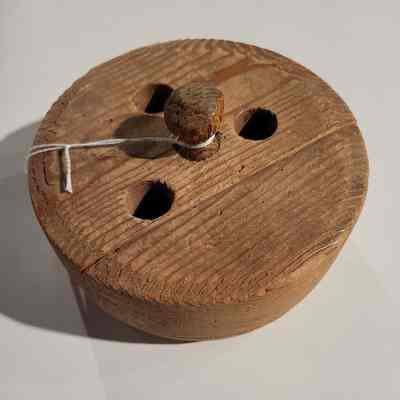

Basket Mold
Name/Title
Basket Mold
Lexicon
Description
Softwood basket mold
Acquisition
Source (if not Accessioned)
Abenaki Cultural Conservancy
Ethnography
Made/Created
Date made
circa 1920
Dimensions
Entry/Object ID
L2024.3.120


Fish Trap
Name/Title
Fish Trap
Lexicon
Description
Cylindrical, ash splint device with interior woven cone.
Use
Trapping fish (eels)
Acquisition
Source (if not Accessioned)
Abenaki Cultural Conservancy
Ethnography
Made/Created
Date made
circa 1900
Dimensions
Materials
Material
Ash Splint
Entry/Object ID
L2024.3.109
Context
This woven ash splint eel trap (missing the basketry cap on the far end) is only the second fish trap from the entire American Abenaki area. The other, now housed in the ECHO, Leahy Center for Lake Champlain collections in Burlington was from the Connecticut River Valley.


Fruit Basket
Name/Title
Fruit Basket
Lexicon
Description
Woven, ash splint basket with handle. Square base with round rim.
Ethnography
Made/Created
Date made
circa 1900
Dimensions
Materials
Material
Ash Splint
Entry/Object ID
L2024.3.110
Context
The small basket holding about a peck would be useful for carrying a few fruits and vegetables from the garden to the kitchen. It came from the same Fairfield, VT source as the large goose down basket (L2024.3.111) and was said to have been made by the same "Indian" family. This example is important in that it is the only one with a carved bail handle that can be assigned a Vermont provenance.


Horse Feed Basket
Name/Title
Horse Feed Basket
Lexicon
Description
Conical, ash-splint woven basket with wooden rim. Remains of leather straps.
Acquisition
Source (if not Accessioned)
Abenaki Cultural Conservancy
Made/Created
Date made
circa 1870
Dimensions
Materials
Material
Ash Splint
Entry/Object ID
L2024.3.177
Context
This is an amazing ash-splint utility basket one of only two that Wiseman has ever seen in the antiques trade. It is designed to add feed or something nicer for the horse to eat in the bottom of the tapered subconical basket while it is tethered. There are the remains of two black leather straps that affix the basket to the horse’s harness. It is uncertain at this time whether the basket is Native-made, but the Nulhegan Tribal records show several local and itinerant Indigenous basket sellers in the area in the early 20th century, and presumably they had parents who also made and sold baskets in the Northeast Kingdom. Large, coarse primitive baskets were known to have been made by both Euro-Americans and Abenakis.


Needlework Basket
Name/Title
Needlework Basket
Lexicon
Description
Sweetgrass sewing basket with tatted and crocheted contents. The basket has four interior features: a pincushion with green velveteen dome top (and 4 pins), a thimble holder, a scissors holder and a lidded compartment to store tiny things in (about 1.5" square and .5" deep.
This does not appear to have been colored.
The magnifying glass has two numbers scratched on it "13" and "3" It has a tiny handle. The rim and handle are a flat grey metal.
This does not appear to have been colored.
The magnifying glass has two numbers scratched on it "13" and "3" It has a tiny handle. The rim and handle are a flat grey metal.
Acquisition
Accession
2010.2
Ethnography
Relationships
Related Person or Organization
Sheridan, Lena Caverzasi (1913-2008)
Person or Organization
Related Places
Place
Montpelier
City
Washington County
County
Vermont
State/Province
United States of America
Country
North America
Dimensions
Dimension Description
Overall
Materials
Material
Sweetgrass, Cotton, Crochet
Entry/Object ID
2010.2a-b
Context
Used by Lena Caverzasi Sheridan


Pack Basket
Name/Title
Pack Basket
Lexicon
Description
Ash-splint pack basket with birch or maple rim
Acquisition
Source (if not Accessioned)
Abenaki Cultural Conservancy
Ethnography
Made/Created
Date made
circa 1900
Dimensions
Materials
Material
Ash Splint
Entry/Object ID
L2024.3.175
Context
Every hunter carried his Indian pack basket into the field, and they sat in many bark and cedar & canvas canoes back in the day. Many others that I found, mostly with nailed or riveted rims retained that leather or fabric shoulder straps, but this one does not seem to ever had them, since there is no strap wear on the splints at all. I would surmise that this may have been used inside a camp or in a canoe. The distinctive loop handle allowed the basket to be slung from the stump of a tree-branch to keep some, but not all animals from finding food or other edibles.
This is the only native-made pack basket I have found that has a good far-north central Vermont provenance from Averill, VT, near the Canadian Border. It has all of the distinctive characteristics of a handmade Native style pack basket that are accepted in Maine. The spear shaped prongs that hold the loop handle to the basket rim are especially distinctive. It still has its original copper-riveted web shoulder straps.
This is the only native-made pack basket I have found that has a good far-north central Vermont provenance from Averill, VT, near the Canadian Border. It has all of the distinctive characteristics of a handmade Native style pack basket that are accepted in Maine. The spear shaped prongs that hold the loop handle to the basket rim are especially distinctive. It still has its original copper-riveted web shoulder straps.


Sewing Basket
Name/Title
Sewing Basket
Lexicon
Description
Sweetgrass basket and lid with embroidery thread and binding ribbon
Acquisition
Source (if not Accessioned)
Abenaki Cultural Conservancy
Ethnography
Made/Created
Date made
circa 1920
Dimensions
Materials
Material
Sweetgrass
Entry/Object ID
L2024.3.101a-b
Context
Probably Odanak


Sweetgrass Bundles
Name/Title
Sweetgrass Bundles
Lexicon
Description
Two bundles of sweetgrass tied with torn strips of bedsheet
Use
Scent air in home or drawer
Acquisition
Source (if not Accessioned)
Abenaki Cultural Conservancy
Relationships
Related Person or Organization
Gravel, Benjamin Frederick (1895-1988)
Person or Organization
Made/Created
Date made
circa 1920
Dimensions
Entry/Object ID
L2024.3.64a-b
Context
This set of sweetgrass bundles, collected by Swanton basketmakers in the early 20th century, are tied with rip-strips of cotton sheets. Swanton historian Ben Gravel said that he collected these from a Back Bay family in whose house they had hung for fifty years. They were traditionally used to sweeten the air in a home or put in drawers to keep away mustiness.


Sweetgrass Sewing Basket
Name/Title
Sweetgrass Sewing Basket
Lexicon
Description
a & b: woven ash splint and sweetgrass round basket with lid. Varying width ash weavers and sweetgrass bundles. Lid has a raised, looped design (cowiss) and small ring handle.
c: Pin Cushion of velvet with woven ash splint base
d: Woven sweetgrass scissor case
e: Woven sweetgrass Needle case (etui)
c: Pin Cushion of velvet with woven ash splint base
d: Woven sweetgrass scissor case
e: Woven sweetgrass Needle case (etui)
Acquisition
Source (if not Accessioned)
Abenaki Cultural Conservancy
Ethnography
Relationships
Related Person or Organization
Gravel, Benjamin Frederick (1895-1988)
Person or Organization
Made/Created
Date made
circa 1900
Materials
Material
Ash Splint, Sweetgrass
Entry/Object ID
L2024.3.104a-e
Context
This is a very rare piece, there are hundreds of baskets like this all over Vermont in antique shops, never with any good provenance. They could be made by Akwesasne Mohawks, Canadian Abenakis or Maine Indians, we will probably never know until a comprehensive stylistic research project can delimit tribal origins. This may not be possible. This basket was purchased from “a Local Indian family” (presumably the Lapans) by Mrs. Bell of Swanton Vermont in the early 20th century. All other Swanton-made baskets are coarse utility baskets or open work baskets without any Sweetgrass interweaving like this one. The basket depth and cowiss over weave decoration are atypical of Quebec Abenaki production. This was from the collection of Swanton Historian Ben Gravel who received the basket during the 1959 Champlain celebration.